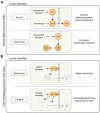Principles Governing Locomotion in Vertebrates: Lessons From Zebrafish
- PMID: 30271327
- PMCID: PMC6146226
- DOI: 10.3389/fncir.2018.00073
Principles Governing Locomotion in Vertebrates: Lessons From Zebrafish
Abstract
Locomotor behaviors are critical for survival and enable animals to navigate their environment, find food and evade predators. The circuits in the brain and spinal cord that initiate and maintain such different modes of locomotion in vertebrates have been studied in numerous species for over a century. In recent decades, the zebrafish has emerged as one of the main model systems for the study of locomotion, owing to its experimental amenability, and work in zebrafish has revealed numerous new insights into locomotor circuit function. Here, we review the literature that has led to our current understanding of the neural circuits controlling swimming and escape in zebrafish. We highlight recent studies that have enriched our comprehension of key topics, such as the interactions between premotor excitatory interneurons (INs) and motoneurons (MNs), supraspinal and spinal circuits that coordinate escape maneuvers, and developmental changes in overall circuit composition. We also discuss roles for neuromodulators and sensory inputs in modifying the relative strengths of constituent circuit components to provide flexibility in zebrafish behavior, allowing the animal to accommodate changes in the environment. We aim to provide a coherent framework for understanding the circuitry in the brain and spinal cord of zebrafish that allows the animal to flexibly transition between different speeds, and modes, of locomotion.
Keywords: excitatory interneurons; motor behavior and motor control; neural networks; plasticity; spinal cord.
Figures





References
-
- Agduhr E. (1922). Über ein zentrales Sinnesorgan (?) bei den Vertebraten. Z. Anat. Entwicklungsgesch. 66, 223–360. 10.1007/bf02593586 - DOI
Publication types
MeSH terms
LinkOut - more resources
Full Text Sources

